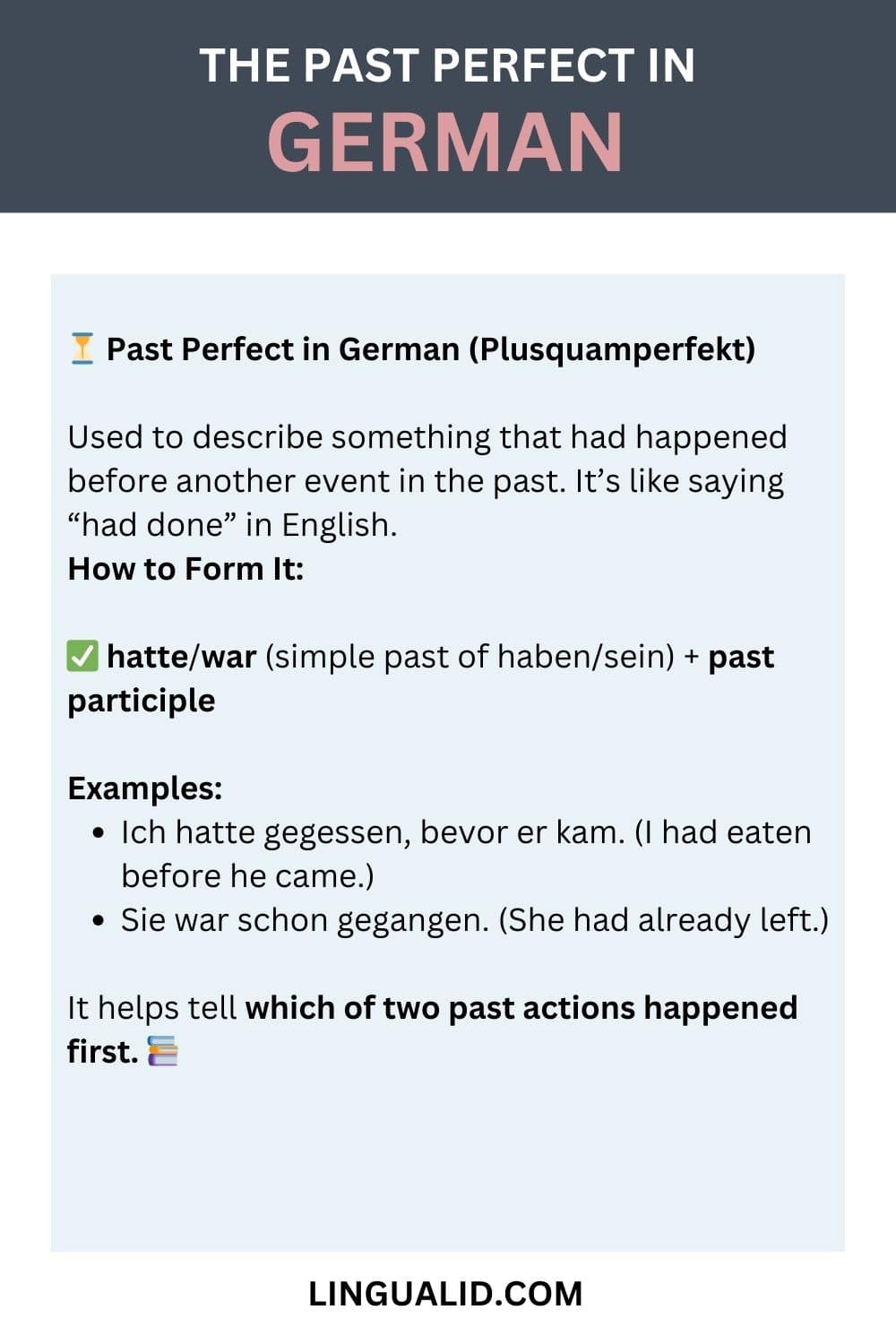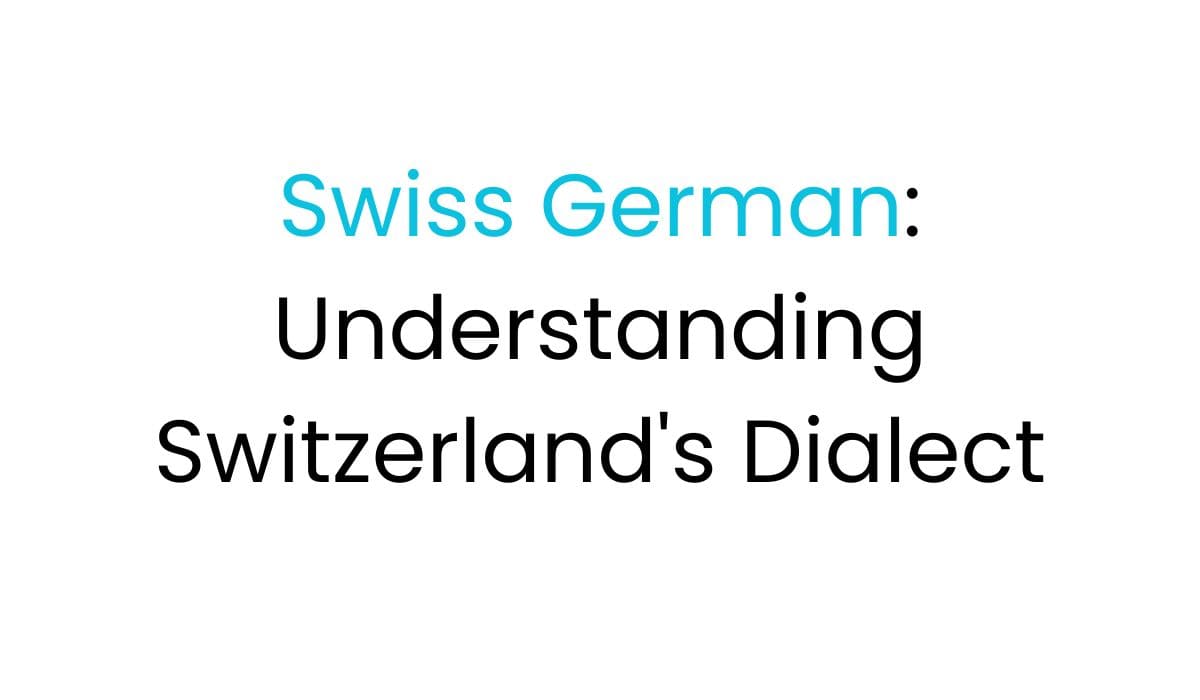Learning the past perfect in German (Plusquamperfekt) can change how you tell stories and communicate. It’s a key part of German grammar that lets you talk about past events in detail. This skill is crucial for anyone learning German.
The past perfect in German is important for talking about actions that happened before another event in the past. It’s different from the simple past tense because it makes it clear when things happened. This helps tell stories in the right order.
For those learning German, the Plusquamperfekt is a powerful tool. It helps make written and formal communication more detailed and accurate. This is especially true for talking about actions that are finished.

Key Takeaways
- Plusquamperfekt helps describe actions completed before another past event
- Used primarily in written German and formal contexts
- Requires understanding of auxiliary verbs “haben” and “sein”
- Critical for creating clear narrative sequences
- More complex than simple past tense
- Essential for advanced German language skills
- Key Takeaways
- Definition and Basic Concept
- When to Use Past Perfect in German
- Comparison with English Past Perfect
- Selecting the Right Auxiliary Verb: Haben
- When to Use Sein
- Common Mistakes to Avoid
- Common Irregular Verb Patterns
- Memorization Techniques
- Practice Examples
- Formal Writing Contexts
- Conversational German
- Regional Variations
- What is the German past perfect (Plusquamperfekt) and how is it different from the simple past?
- How do I form the past perfect in German?
- When should I use 'haben' or 'sein' as the auxiliary verb?
- What are some common signal words that indicate the use of past perfect?
- How do irregular verbs work in the past perfect?
- Is the past perfect used differently in written and spoken German?
- What are some common mistakes learners make with the past perfect?
- How does the German past perfect compare to the English past perfect?
- Are there any shortcuts to learning past participle formations?
- How important is mastering the past perfect for German fluency?
Understanding Past Perfect in German (Plusquamperfekt)
The German past perfect tense, or Plusquamperfekt, is quite interesting. It helps us talk about actions that happened before another past event. This makes stories more detailed and interesting.
This tense is very important for talking about past events in a clear way. It lets us share stories and experiences with great detail.
Definition and Basic Concept
The Plusquamperfekt shows actions that happened before another past event. It’s like a time machine in language. It helps us find exact moments in stories or history.
- Indicates completed actions before another past event
- Equivalent to English past perfect tense
- Provides context for sequential past events
When to Use Past Perfect in German
German speakers use the past perfect in certain situations. These situations need clear time references. Here are some examples:
- Storytelling and narrative descriptions
- Historical writing
- Formal academic communication
- Explaining complex sequence of past events
Comparison with English Past Perfect
The German past perfect is similar to English but has its own special points. Both use helper verbs, but German has strict rules for haben and sein.
German speakers often use simpler tenses in everyday talk. But knowing the differences is crucial for getting better at German.
Formation Rules of German Past Perfect
Learning German past perfect needs knowing how to form past participles. The German past perfect (Plusquamperfekt) is made by combining an auxiliary verb with a past participle. This shows actions done before another past event.
The way to form it depends on two main auxiliary verbs: haben (to have) and sein (to be). Each verb type has its own rules for conjugation:
- Weak verbs add “ge-” prefix and “-t” suffix
- Strong verbs change stem vowels and add “ge-” prefix
- Mixed verbs mix weak and strong verb features
Forming past participles has key rules:
- Verbs ending in “-ieren” don’t get the “ge-” prefix
- Inseparable verbs skip the “ge-” prefix
- Separable verbs put “ge-” between prefix and verb stem
To make past perfect sentences, use the auxiliary verb in simple past form. Then add the past participle. German learners must focus on verb type and conjugation for correct grammar.
Auxiliary Verbs: Haben and Sein in Past Perfect
Learning about auxiliary verbs is key to mastering the German past perfect tense. Haben and sein are the main verbs used to form compound tenses. They help express past actions accurately.
It’s important for German learners to understand the conjugation of sein. Each auxiliary verb has its own role in making sentences grammatically correct.
Selecting the Right Auxiliary Verb: Haben
Haben is the most common auxiliary verb in German. It’s used with:
- Transitive verbs
- Intransitive verbs without state changes
- Reflexive verbs
- Modal verbs
Verbs like schlafen (to sleep), arbeiten (to work), and singen (to sing) need haben.
When to Use Sein
Sein is for verbs showing movement or big state changes. It’s used for:
- Verbs of motion (gehen, fahren, laufen)
- Verbs expressing transformations
- Verbs describing transitions between states
Common Mistakes to Avoid
Choosing the right auxiliary verb can be tricky for German learners. Here are some tips:
- Most verbs use haben by default
- Verbs involving physical movement typically use sein
- Context matters in verb selection
Practice with different examples to get better at using these verbs. It will help improve your German skills.
Past Perfect with Regular Verbs

Learning German grammar rules for regular verbs is key for effective communication. Regular verbs in German have a simple pattern. This makes learning the past perfect (Plusquamperfekt) easier.
To form the past perfect with regular verbs, follow a clear structure. First, add ge- to the verb stem. Then, add -t at the end. This method creates the past participle of weak verbs.
- Add ge- before the verb stem
- Append -t at the end of the verb stem
- Combine with the appropriate auxiliary verb (haben or sein)
Now, let’s look at some examples of regular verb conjugation in the past perfect:
| Infinitive | Past Participle | English Translation |
|---|---|---|
| lernen | gelernt | to learn |
| spielen | gespielt | to play |
| tanzen | getanzt | to dance |
Practice is vital to master these German grammar rules. By regularly using the ge- and -t pattern, you’ll get better at compound verb conjugation in the past perfect tense.
Past Perfect with Irregular Verbs
Learning irregular verbs in German can be tough, especially for the past participle. The past perfect tense needs a good grasp of how these verbs change.
Irregular verbs in German have their own rules, unlike regular verbs. These strong verbs change a lot in their past participle form.
Common Irregular Verb Patterns
Knowing the main patterns of irregular verbs is key to mastering the past perfect tense. Here are some important points:
- Verb stems often change completely
- Vowel modifications are frequent
- Prefixes may alter the verb’s meaning
Memorization Techniques
Learning irregular verbs needs smart strategies:
- Group similar verbs together
- Create visual memory associations
- Practice frequent irregular verb conjugations
Practice Examples
Let’s look at some examples of irregular verbs in the past perfect tense:
- gehen (to go): Ich war gegangen (I had gone)
- nehmen (to take): Er hatte genommen (He had taken)
- singen (to sing): Sie hatte gesungen (She had sung)
Getting good at irregular verbs takes regular practice and seeing different verb forms. Each irregular verb has its own challenge in forming the past participle. This makes them crucial for mastering German grammar.
Signal Words and Time Markers

Learning about signal words is key to getting the past perfect (Plusquamperfekt) in German. These words tell us when to use this tense in our conversations.
Temporal conjunctions are important for the past perfect tense. They include:
- nachdem (after)
- bevor (before)
- als (when)
- bis (until)
Examples show how these words help pick the right verb tense. For example, they help arrange past events in order.
| Signal Word | Function in Past Perfect | Example Usage |
|---|---|---|
| nachdem | Indicates action completed before another past action | Nachdem ich gegessen hatte, ging ich schlafen |
| bevor | Signals action happening before another past event | Bevor er ankam, hatte ich bereits gewartet |
| als | Marks specific point in past time | Als ich nach Hause kam, hatte er schon gekocht |
Knowing these signal words makes your German sentences clearer. It helps you talk about past events and their connections more accurately.
Past Perfect in German: Written vs Spoken Usage
The German past perfect tense shows interesting differences between written and spoken language. Knowing how it’s used in different situations helps learners understand German better.
Students of German soon find that the past perfect tense is used very differently in formal writing and everyday talk. It’s more common in written texts, like books and academic papers.
Formal Writing Contexts
In academic and literary writing, the Plusquamperfekt is key. It helps create a deep story. Writers use it to:
- Describe actions that happened before another past event
- Give historical background
- Make complex time relationships
Conversational German
Spoken German uses past tenses in a simpler way. People often choose easier forms. Here are some interesting facts:
| Tense Type | Usage in Spoken German |
|---|---|
| Perfect Tense (Perfekt) | 80% of conversations |
| Simple Past (Präteritum) | 20% of conversations |
Regional Variations
German dialects add more complexity to past perfect use. With over 250 regional dialects, how speakers use tenses can vary a lot. Rural areas often have more unique ways of speaking compared to cities.
Language learners should remember that while there are rules, spoken German values getting the message across more than following strict grammar.
Complex Sentence Structures with Plusquamperfekt
Learning complex German sentence structures is tough. You need to understand compound verb conjugation and the Plusquamperfekt (past perfect) tense well. It gets even harder with subordinate clauses and complex time relationships.
In German, subordinate clauses work differently than in English. The auxiliary verb goes to the end of the clause. This makes learning German a unique challenge. For example:
- Ich wusste, dass sie das Lied gesungen hatte (I knew that she had sung the song)
- Nachdem er nach Hause gekommen war (After he had come home)
German sentence structure is complex because of verb placement. In compound verb conjugation, the past participle is at the end. Auxiliary verbs follow specific rules. This forces learners to think differently about building sentences.
Here are some tips for dealing with these complex structures:
- Practice making subordinate clauses
- Learn the rules for verb placement
- Know the different types of clauses
- Be flexible with sentence building
Advanced learners must focus on how the Plusquamperfekt works with other tenses. Creating detailed temporal expressions shows true skill in German.
Common Challenges and Solutions
Learning German grammar can be tough, especially with the Plusquamperfekt (past perfect) tense. Many find it hard to understand irregular verbs in German.
The main problems include:
- Picking the right auxiliary verb (haben or sein)
- Creating correct past participles
- Knowing when to use the past perfect tense
- Correctly conjugating irregular verbs
Choosing the right auxiliary verb is a big challenge. Sein is used for verbs about movement or change, while haben is for other actions. This rule can be hard for learners.
To solve these issues, try these tips:
- Practice verb conjugations often
- Make memory aids for irregular verb patterns
- Use context-based learning
- Listen to native speakers and study their language use
Building a systematic approach to German grammar boosts confidence. Focus on verbs that need sein, like fahren (to drive) and gehen (to go). Regular practice and listening to native speakers will help you understand the past perfect tense better.
Conclusion
Learning the past perfect in German opens up new ways to express yourself. It makes understanding German grammar rules easier. You can tell complex stories with precision and clarity.
Practice is key to mastering this skill. By working with verb forms, you get better at making complex sentences. At first, German grammar might seem tough, but with effort, you’ll speak more fluently.
Understanding the past perfect is a big step in learning German. Every verb and sentence you learn helps you communicate better. Remember, every challenge in German is a chance to grow and learn more.
Mastering the past perfect will boost your German skills for school, work, or just talking with friends. Keep exploring and practicing German grammar. It’s a rich and rewarding language to learn.
FAQ
What is the German past perfect (Plusquamperfekt) and how is it different from the simple past?
How do I form the past perfect in German?
When should I use ‘haben’ or ‘sein’ as the auxiliary verb?
What are some common signal words that indicate the use of past perfect?
How do irregular verbs work in the past perfect?
Is the past perfect used differently in written and spoken German?
What are some common mistakes learners make with the past perfect?
How does the German past perfect compare to the English past perfect?
Are there any shortcuts to learning past participle formations?
How important is mastering the past perfect for German fluency?
Oualid Cheddadi is a language enthusiast who created Lingualid with the mission to inspire independent language learners worldwide, regardless of the language they are learning. The name “Lingualid” is derived from the Portuguese word for “language,” “língua,” and the last three letters of Oualid’s name, “Lid.”



